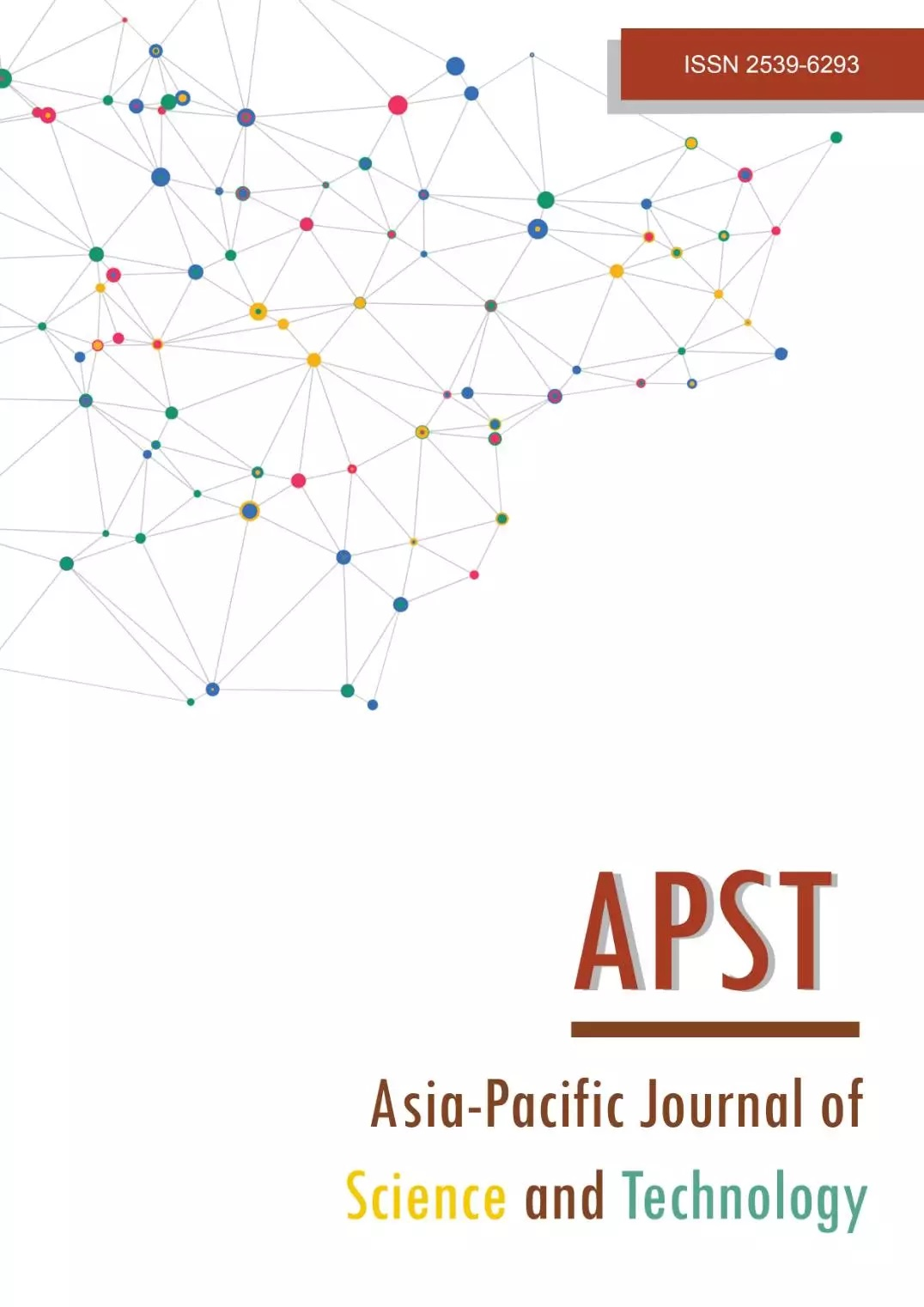Microbiological evaluation of Thai fermented fish (pla-ra) production contact surfaces
Main Article Content
Abstract
Pla-ra is a lactic acid fermented fish product in Thailand, typically consumed as a side dish. Multiple outbreaks have been linked to the consumption of fermented foods, including pla-ra. During the fermentation process, pla-ra is in direct contact with a food container for an extended period which is also potentially contaminated with a high number of microorganisms. This research determined the prevalence of pathogenic bacteria on the surface of pla-ra production containers. From three different pla-ra manufacturers in Khon Kaen province, Thailand, 110 swab samples were collected from 25 pla-ra clay and polyethylene (PE) production containers. The samples, cultivated in selective media, were contaminated with Bacillus cereus (7.64 ± 0.13 log10 colony forming unit (CFU)/cm2), Clostridium perfringens (6.53 ± 0.21 log10 CFU/cm2), Escherichia coli (8.23 ± 0.15 log10 CFU/cm2), Salmonella spp. (5.73 ± 0.22 log10 CFU/cm2) and Staphylococcus aureus (7.81 ± 0.16 log10 CFU/cm2). The 16s rRNA sequencing analysis confirmed the presence of Klebsiella aerogenes, Clostridium perfringens, Escherichia coli, Listeria innocua, and Staphylococcus aureus. The population of each bacteria found on the surfaces was, respectively, 7.64 ± 0.18, 7.79 ± 0.14, 8.40 ± 0.24, 7.82 ± 0.14, and 8.18 ± 0.17 log10 CFU/cm2 in clay containers and 7.39 ± 0.24, 7.39 ± 0.26, 8.12 ± 0.08, 8.32 ± 0.15, and 8.46 ± 0.26 log10 CFU/cm2 in PE containers. The specific environmental conditions and the handling of raw materials, including contact time during fermentation and sanitation, affect the possibility of cross-contamination. These results highlight the importance of pasteurization of pla-ra to ensure its safety.
Article Details
References
Steinkraus KH. Industrialization of indigenous fermented foods. 2nd ed. New York: CRC Press; 2004.
Rattanasuk S, Boonbao J, Sankumpa, Surasilp T. Foodborne pathogens in fermented fish purchased in
Selaphum, Roi Et. Intl Conf Sci Tech. 2015;1(3):178-181.
Sangjindavong M, Chuapoehuk P, Runglerdkriangkrai J, Klaypradit W, Vareevanich D. Fermented fish
product (pla-ra) from marine fish and preservation. Kasersart J. 2008;42:129-136.
Capozzi V, Fragasso M, Romaniello R, Berbegal C, Russo P, Spano G. Spontaneous food fermentations
and potential risks for human health. Fermentation J. 2017;3(4):49-51.
Nout MJR. Fermented foods and food safety. Food Res Int. 1994;27(3):291-298.
Meloni D. Presence of Listeria monocytogenes in Mediterranean-style dry fermented sausages. J Food
Microbiol. 2015;4(1):34-50.
Donlan RM. Biofilms: microbial life on surfaces. Emerg Infect Dis. 2002;8(9):881-890.
Wirtanen G, Salo S. Microbial contaminants and contamination routes in the food industry. Finland:
Julkaisija-Utgivare Publishing;2007.
Todd EC, Greig JD, Bartleson CA, Michaels BS. Outbreaks where food workers have been implicated in
the spread of foodborne disease: transmission and survival of pathogens in the food processing and
preparation environment. J Food Protection. 2009;72:202-219.
Tallent SM, Knolhoff A, Rhodehamel EJ, Harmon SM, Bennett RW. Bacillus cereus. Bacteriological analytical manual, 8th ed [Internet]. 2019 [cited 2020 Feb 24]. Available from: https://www.fda.gov/food/laboratory-methods-food/bam-chapter-14-bacillus-cereus.
Tallent SM, Knolhoff A, Rhodehamel EJ, Harmon SM, Bennett RW. Clostridium perfringens. Bacteriological analytical manual, 8th ed [Internet]. 2017 [cited 2020 Feb 24]. Available from: https://www.fda.gov/food/laboratory-methods-food/bam-chapter-16-clostridium-perfringens.
Feng P, Weagant SD, Grant MA, Burkhardt W. Enumeration of Escherichia coli and the coliform bacteria. Bacteriological analytical manual, 8th ed [Internet]. 2018 [cited 2020 Feb 20]. Available from: https://www.fda.gov/food/laboratory-methods-food/bam-chapter-4-enumeration-escherichia-coli-and-coliform-bacteria.
Andrews WH, Wang H, Jacobson A, Ge B, Zhang G, Hammack T. Salmonella. Bacteriological analytical manual, 8th ed [Internet]. 2020 [cited 2020 Feb 21]. Available from: https://www.fda.gov/food/laboratory-methods-food/bam-chapter-5-salmonella.
Hitchins AD, Jinneman K, Chen Y. Detection of Listeria monocytogenes in foods and environmental samples, and enumeration of Listeria monocytogenes in foods. Bacteriological analytical manual, 8th ed [Internet]. 2017 [cited 2020 Feb 24]. Available from: https://www.fda.gov/food/laboratory-methods-food/bam-chapter-10-detection-listeria-monocytogenes-foods-and-environmental-samples-and enumeration.
Tallent S, Hait J, Bennett RW, Lancette GA. Staphylococcus aureus. Bacteriological analytical manual, 8th ed [Internet]. 2019 [cited 2020 Feb 22]. Available from: https://www.fda.gov/food/laboratory-methods-food/bam-chapter-12-staphylococcus-aureus.
Nivens DE, Co BM, Franklin MJ. Sampling and quantification of biofilms in food processing and other environments. Food Sci Tech & Nutr. 2009;21:539-568.
Novotny L, Dvorska L, Lorencova A, Beran V, Pavlik I. Fish: a potential source of bacterial pathogen for human beings. J Vet Med. 2004;49(9):343-358.
Pandey PK, Kass PH, Soupir ML, Biswas S, Singh VP. Contamination of water resources by pathogenic bacteria. AMB Express. 2014;4(51):1-16.
Kuzmanović J, Asanin R, Baltic M, Misic D, Dimitrijevic M, Stojanovic M, et al. Presence of Listeria spp in fish samples, fish products and sea products. Acta veterinaria. 2011;61(3):193-203.
Axelsson L, Bjerke GA, McLeod A, Berget I, Holck AL. Growth behavior of Listeria monocytogenes in a traditional Norwegian fermented fish product (Rakfisk), and its inhibition through bacteriophage addition. Foods. 2020;9(2):119-122.
Sofos J. Advances in microbial food safety: Vol 2. NY:Elsevier;2014.
Yankowski A, Kerdsap P, Chang N. An ethnoarchaeological study of salt and salt fermented fish production, use and trade in Northeast Thailand. J Indo Pac Arch. 2015;37:4-13.
Barati A, Ghaderpour A, Chew LL, Bong CW, Thong KL, Chong VC, et al. Isolation and characterization of aquatic-borne Klebsiella pneumoniae from tropical estuaries in Malaysia. Int J Environ Res Public Health. 2016;13(4):426-429.
Gassem MA. Microbiological and chemical quality of a traditional salted-fermented fish (Hout-Kasef) product of Jazan region, Saudi Arabia. Saudi J Bio Sci. 2019;26(1):137-140.
Yah CS, Nwinyi OC, Chinedu SN. Assessment of bacteriological quality of ready to eat food (Meat pie) in Benin city metropolis, Nigeria. African J Microbiol Res. 2009;3(6):390-395.
Wu X, Altman R, Eiteman MA, Altman E. Adaptation of Escherichia coli to elevated sodium concentrations increases cation tolerance and enables greater lactic acid production. Appl Environ Microbiol. 2014;80(9):2880-2888.
Duché O, Trémoulet F, Glaser P, Labadie J. Salt stress proteins induced in Listeria monocytogenes. Appl Environ Microbiol. 2002;68(4):1491-1498.
Rodríguez FP, Valero A, Carrasco E, Garcia RM, Zurera G. Understanding and modelling bacterial
transfer to foods: a review. Trend Food Sci Tech. 2008;19(3):131-144.
Miranda RC, Schaffner DW. Longer contact times increase cross-contamination of Enterobacter aerogenes from surfaces to food. Appl Env Microbiol. 2016;82(21):6490-6496.
Lipschutz BM, Kagan D, Steed L, Kagan E, Lipschutz JH. Contact time for foods of different textures leads to differential bacterial growth: testing the five-second rule. Int J Appl Env Sci. 2016;11(6):1387-1396.


